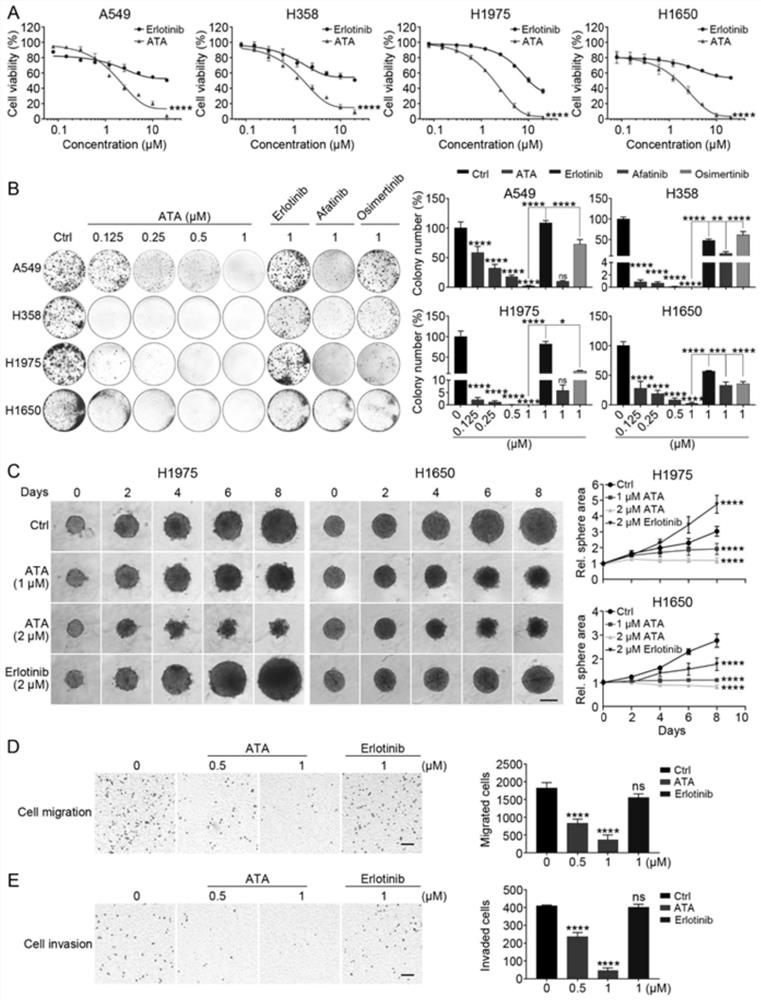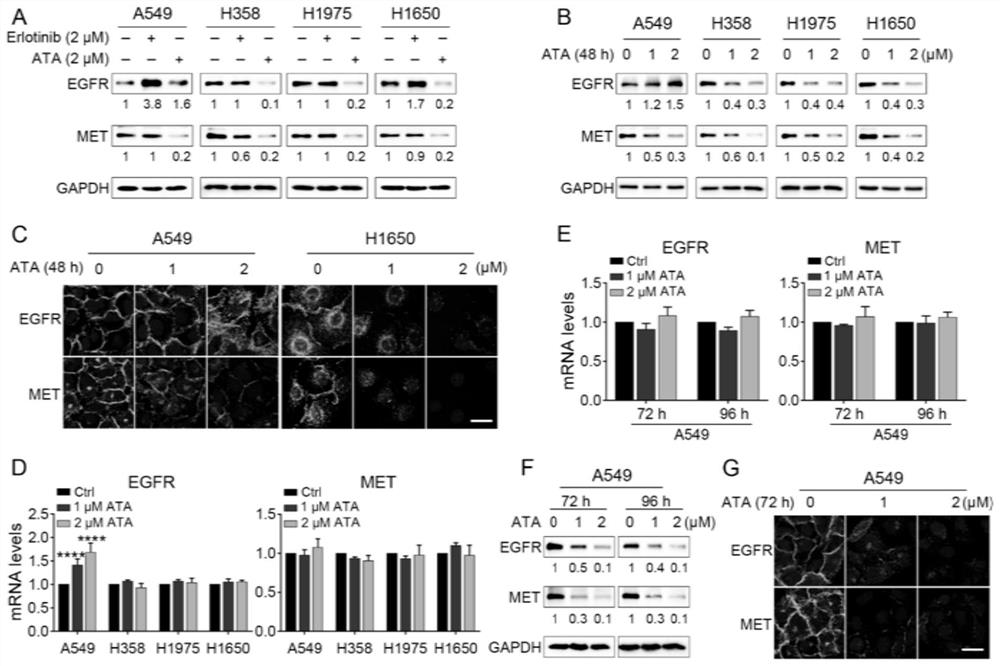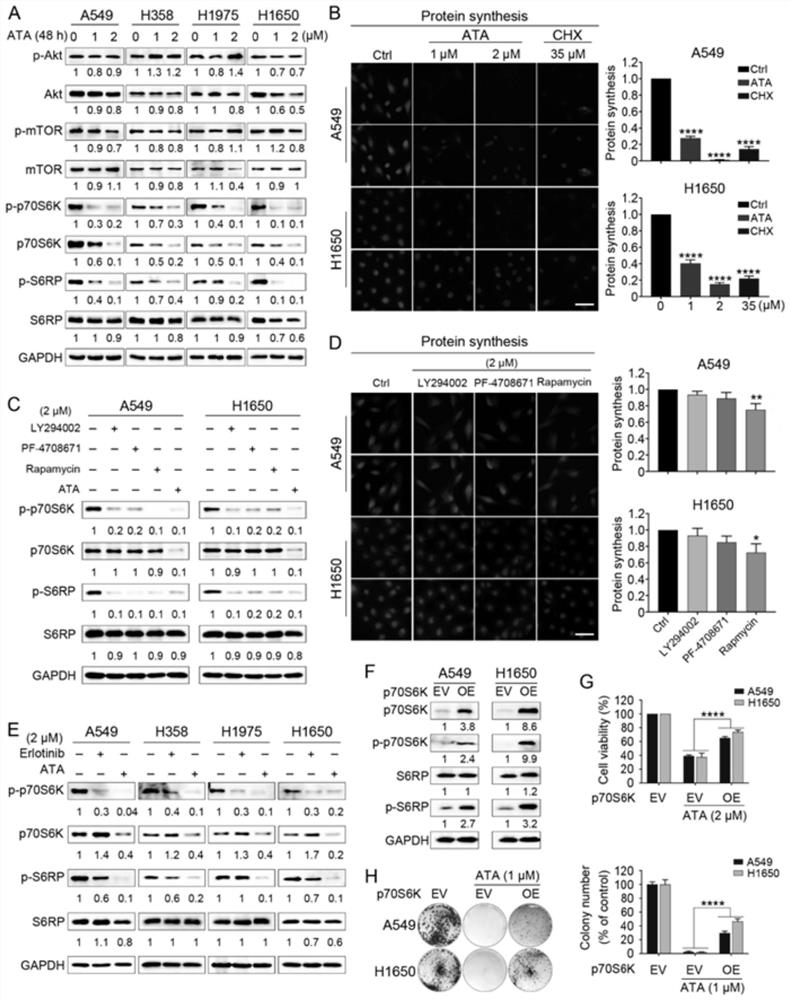Application of acetyltanshinone IIA in preparation of medicine for treating lung cancer and medicine for treating lung cancer
A technology of acetyl salvia miltiorrhiza and medicine, applied in the field of medicines for the treatment of lung cancer, can solve the problems of temporary, EGFRTKIs resistance, incomplete drug response, etc.
- Summary
- Abstract
- Description
- Claims
- Application Information
AI Technical Summary
Problems solved by technology
Method used
Image
Examples
Embodiment 1
[0089] ATA potently inhibits the growth of NSCLC cells with primary or acquired resistance to EGFR TKIs
[0090] Four drug-resistant cell lines were selected, among which A549 and H358 cells had primary resistance to EGFR TKIs (such as Erlotinib, Afatinib, and Osimertinib) due to activating mutations of wild-type EGFR (wt-EGFR) and KRAS. H1975 cells had two mutations in EGFR (L858R and T790M), the second mutation making these cells resistant to erlotinib. H1650 cells had an EGFR-activating mutation (A746-A750 deletion) and a PTEN-deleting mutation. Due to the loss of PTEN, these cells developed resistance to three anti-EGFR drugs, Erlotinib, Afatinib and Osimertinib (as shown in Table 2).
[0091] Table 2 IC of Erlotinib and ATA in drug-resistant NSCLC cells 50 value
[0092]
[0093]
[0094] WT: wild type.
[0095] Among the three EGFR TKIs, comparing the growth inhibitory effect of ATA with the first-generation EGFR TKI: erlotinib, the MTT results showed that in a...
Embodiment 2
[0103] ATA is more effective than Erlotinib in reducing protein levels of EGFR and MET in drug-resistant NSCLC cells
[0104] To determine why ATA was more effective than Erlotinib in inhibiting the growth of drug-resistant NSCLC cells, this example compared their effects on EGFR and MET protein levels in all cell lines used in this study. The results showed that Erlotinib treatment significantly increased the protein levels of EGFR in A549 and H1650. However, in addition to the EGFR protein levels of A549, ATA strongly reduced the EGFR and MET protein levels in drug-resistant NSCLC cells (eg figure 2 shown in A).
[0105] Further, in order to confirm whether ATA can inhibit the growth of drug-resistant NSCLC by reducing the levels of EGFR and MET, A549, H358, H1975 and H1650 cells were treated with 1 or 2 μM ATA for 48 hours, and the results of Western blot showed that: 1 or 2 μM ATA ATA greatly reduced EGFR protein levels by 60-70% in H358, H1975 and H1650 cells, and 2 μM...
Embodiment 3
[0110] ATA inhibits the growth of drug-resistant NSCLC cells by reducing p70S6K
[0111] To study the effect of ATA on the downstream signaling pathways of EGFR and MET, the results of Western blot showed that ATA treatment did not significantly reduce the levels of p-Akt, Akt, p-mTOR and mTOR in most cell lines, but greatly reduced p70S6K protein and levels of its phosphorylated form. In addition, ATA also significantly reduced the phosphorylation of S6 ribosomal protein (S6RP), which can be phosphorylated by p70S6K; however, ATA did not greatly reduce the level of S6RP protein (eg image 3 shown in A). Confocal immunofluorescent staining also confirmed that ATA treatment decreased the levels of p-S6RP in A549 and H358 cells (eg Figure 10 shown in A).
[0112] Since the phosphorylation of S6RP by p70S6K can induce protein synthesis in ribosomes, an experiment was conducted to determine whether the reduction of p70S6K by ATA would affect the synthesis of new proteins. The ...
PUM
 Login to View More
Login to View More Abstract
Description
Claims
Application Information
 Login to View More
Login to View More - R&D
- Intellectual Property
- Life Sciences
- Materials
- Tech Scout
- Unparalleled Data Quality
- Higher Quality Content
- 60% Fewer Hallucinations
Browse by: Latest US Patents, China's latest patents, Technical Efficacy Thesaurus, Application Domain, Technology Topic, Popular Technical Reports.
© 2025 PatSnap. All rights reserved.Legal|Privacy policy|Modern Slavery Act Transparency Statement|Sitemap|About US| Contact US: help@patsnap.com



